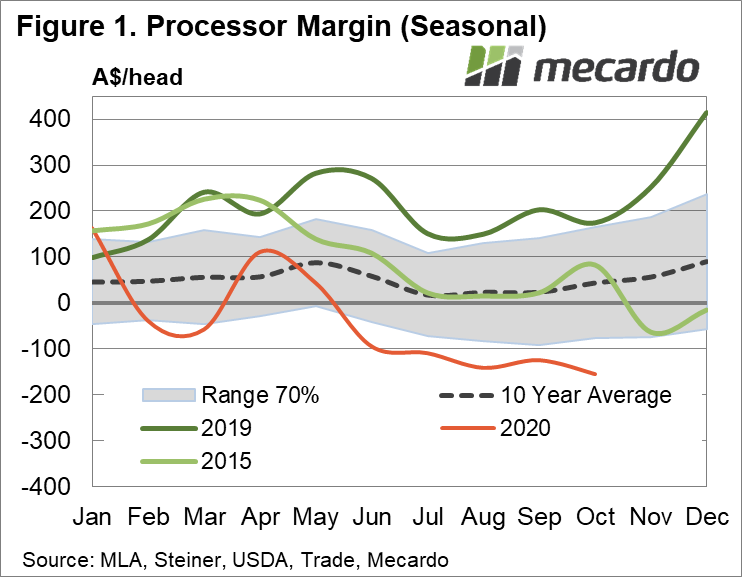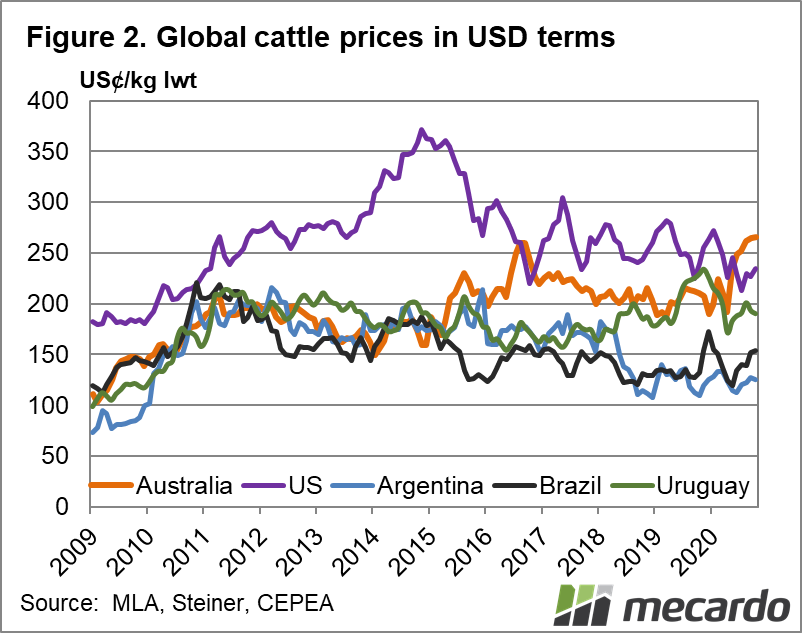The latest update to the Mecardo processor margin model delivers no good news this month, with our estimates being that beef processors are, on average, likely to still be losing money for every animal slaughtered. This is most likely going to continue to limit the amount of upside that the cattle market can possibly achieve going forward.
The Mecardo beef processor margin model update for October 2020 (figure 1) estimates that for every steer or cow slaughtered, processors are sitting around $155 loss per head. This is a not great situation for the industry as the elevated level at which cattle prices are at now are probably unsustainable over the medium to long term.
What is causing the losses? Quite simply, Australia’s beef industry is highly reliant on the export market to absorb the excess beef we produce each year above our domestic requirements. The price we can demand for exported beef is limited by the competitive international market for beef. Looking at (figure 2), Australian beef is among the most expensive in the world, 13% above US domestic prices, and a massive 73% higher than Brazilian prices.
A question that might be raised, is that if processors are truly losing money at current cattle prices, why are they still buying, and keeping prices elevated? The short answer is that it can still be the economically optimal choice to lose money by staying in operation in the short term, if the alternative is losing more over the long run from business disruption.
Many processors are in regional areas, and if they lay off their workers, there is a good chance that they will move away, or, at best, retrain and be unwilling to return to an employer who cannot offer job security, requiring the investment of significant time and costs to attract and train new workers when market conditions return to a more profitable environment.
Also, the customers of beef processors; both internationally and domestically are looking for stable and reliable supply, and in some cases, long term contracts may already be written guaranteeing this. Beef is a fairly substitutable commodity, and if a customer is dropped, a supplier may have difficulty winning them back once they have gone elsewhere.
Beef processing is a long-term game. A business of swings and roundabouts, highs and lows, where processors go through periods of both extreme profitability, and taking a hit and losing money while remaining in operation in the short to medium term to maintain their skilled workforces, and relationships with key customers. If you consider Figure 3, it has been generally turbulent times for processors over the last 20 years. Periods of loss making business conditions have occured, while extremely profitable bonanzas like last year are more of a rarity in the scheme of things.
As restockers compete with processors for young cattle and cows, this reduces the pool of cattle for slaughter available to processors; who, collectively, require a fairly non-negotiable minimum number of cattle. As such, the price for this smaller supply of cattle gets bid up by the processors who are in competition with one another in order to meet their contractual obligations to customers, and maintain them into the long term.
Of course though, there is a limit to how much a processor is willing to lose in the short term in pursuit of customer retention, and we are probably close to that point currently, as losses haven’t been estimated to be as deep since 2016.
What does it mean?
Many beef processors may be losing money, given where Australian cattle prices are and the price that can be achieved for beef in export markets currently. This will keep a lid on cattle prices as there is a limit to how large a loss processors are willing to sustain in the short term, so don’t expect beef prices to see much more upside unless international prices lift significantly first.
Have any questions or comments?
Key Points
- Processors estimated to be losing $155 / head on cattle
- Australian cattle are among the most expensive in the world- 73% above Brazil.
- The last time processor losses were this big in the last 20 years was 2016.
Click on figure to expand
Click on figure to expand
Click on figure to expand
Data sources: MLA, USDA, Stats Canada, Mecardo.














